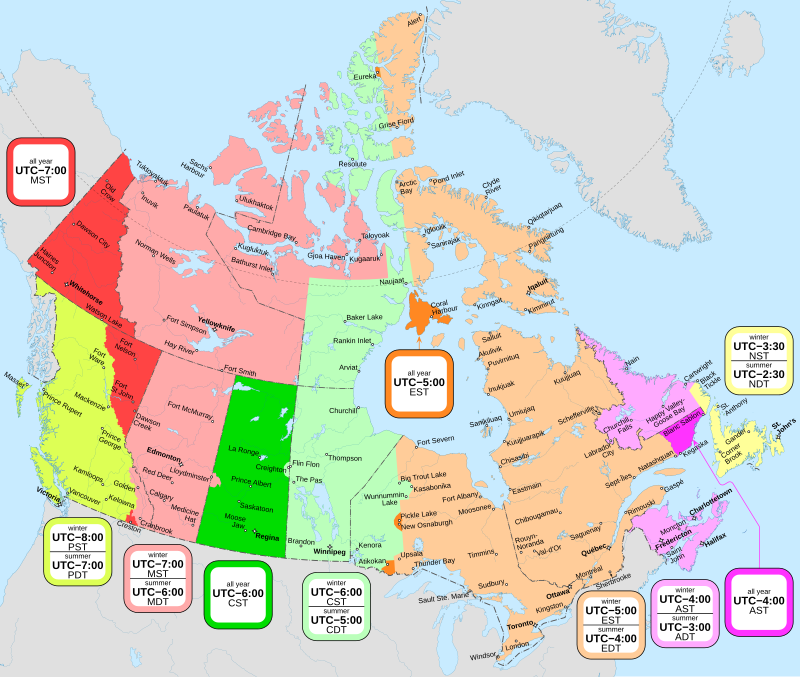Canada Current Time & Time Zone Map & Time Zone
Live time zones for all Canadian provinces and territories

Newfoundland Time
UTC-2:30 (NDT)
21:12:00
Sunday, October 19, 2025
Example city: St. John's
Atlantic Time
UTC-3:00 (ADT)
20:42:00
Sunday, October 19, 2025
Example city: Halifax
Blanc Sablon Time
UTC−04:00 (AST, year round)
19:42:00
Sunday, October 19, 2025
Example city: Blanc Sablon
Eastern Time
UTC-4:00 (EDT)
19:42:00
Sunday, October 19, 2025
Example city: Toronto
Southampton lsland Time
UTC−05:00 (EST, year round)
18:42:00
Sunday, October 19, 2025
Example city: Southampton lsland
Central Time
UTC−05:00 (CDT)
18:42:00
Sunday, October 19, 2025
Example city: Winnipeg
Regina Time
UTC−06:00 (CST, year round)
17:42:00
Sunday, October 19, 2025
Example city: Regina
Mountain Time
UTC−06:00 (MDT)
17:42:00
Sunday, October 19, 2025
Example city: Edmonton
Whitehorse Time
UTC−07:00 (MST, year round)
16:42:00
Sunday, October 19, 2025
Example city: Whitehorse
Pacific Time
UTC−07:00 (PDT)
16:42:00
Sunday, October 19, 2025
Example city: Vancouver
1. How Many Time Zones Does Canada Have?
Canada spans 6 primary time zones from UTC−08:00 (Pacific Time) to UTC−03:30 (Newfoundland Time). Some locations observe standard time year‑round (e.g., most of Saskatchewan, Yukon), while most provinces observe Daylight Saving Time (DST).
2. Canada Time Zones (Map Reference)
Newfoundland Time (NT/NDT)
Standard: UTC−03:30; DST: UTC−02:30 — Newfoundland and parts of Labrador.
Atlantic Time (AST/ADT)
Standard: UTC−04:00; DST: UTC−03:00 — Nova Scotia, New Brunswick, Prince Edward Island, most of Labrador; Blanc‑Sablon, QC stays on AST year‑round.
Eastern Time (EST/EDT)
Standard: UTC−05:00; DST: UTC−04:00 — Ontario, Québec (majority), Nunavut (parts).
Central Time (CST/CDT)
Standard: UTC−06:00; DST: UTC−05:00 — Manitoba, Saskatchewan (Regina, Saskatoon stay on CST year‑round), Nunavut (parts), NW Ontario (parts).
Mountain Time (MST/MDT)
Standard: UTC−07:00; DST: UTC−06:00 — Alberta, Northwest Territories (most), British Columbia (parts). Yukon stays on MST year‑round.
Pacific Time (PST/PDT)
Standard: UTC−08:00; DST: UTC−07:00 — British Columbia (most).
3. Daylight Saving Time schedule (Canada)
Begins on the second Sunday in March at 2:00 a.m. local time (clocks move forward to 3:00 a.m.).
Ends on the first Sunday in November at 2:00 a.m. local time (clocks move back to 1:00 a.m.).
Exceptions: Areas on year‑round standard time include most of Saskatchewan, Yukon (MST year‑round), and Blanc‑Sablon, Québec, among others.
4. History of Canada Time Zones
Canada adopted time zones in the late 19th century alongside the U.S. for railway scheduling; most provinces adopted DST in the 20th century. Recent changes include Yukon moving to year‑round MST (2020) and some provinces aligning DST dates with the U.S. Energy Policy Act (2007).
5. Learn More About Canada Time Zones
Canada Current Time & Time Zone Map & Time Zone
Live time zones for all Canadian provinces and territories

Newfoundland Time
UTC−03:30 (NT)
21:12:00
Sunday, October 19, 2025
Example city: St. John's
Atlantic Time
UTC−04:00 (AT)
20:42:00
Sunday, October 19, 2025
Example city: Halifax
Blanc Sablon Time
UTC−04:00 (AST, year round)
19:42:00
Sunday, October 19, 2025
Example city: Blanc Sablon
Eastern Time
UTC−05:00 (ET)
19:42:00
Sunday, October 19, 2025
Example city: Toronto
Southampton lsland Time
UTC−05:00 (EST, year round)
18:42:00
Sunday, October 19, 2025
Example city: Southampton lsland
Central Time
UTC−06:00 (CT)
18:42:00
Sunday, October 19, 2025
Example city: Winnipeg
Regina Time
UTC−06:00 (CST, year round)
17:42:00
Sunday, October 19, 2025
Example city: Regina
Mountain Time
UTC−07:00 (MT)
17:42:00
Sunday, October 19, 2025
Example city: Edmonton
Whitehorse Time
UTC−07:00 (MST, year round)
16:42:00
Sunday, October 19, 2025
Example city: Whitehorse
Pacific Time
UTC−08:00 (PT)
16:42:00
Sunday, October 19, 2025
Example city: Vancouver
1. How Many Time Zones Does Canada Have?
Canada spans 6 primary time zones from UTC−08:00 (Pacific Time) to UTC−03:30 (Newfoundland Time). Some locations observe standard time year‑round (e.g., most of Saskatchewan, Yukon), while most provinces observe DST.
2. Canada Time Zones (Map Reference)
Newfoundland Time (NT)
UTC−03:30 — Newfoundland and parts of Labrador.
Atlantic Time (AT)
UTC−04:00 — Nova Scotia, New Brunswick, Prince Edward Island, most of Labrador; Blanc‑Sablon, QC stays on AST year‑round.
Eastern Time (ET)
UTC−05:00 — Ontario, Québec (majority), Nunavut (parts).
Central Time (CT)
UTC−06:00 — Manitoba, Saskatchewan (Regina, Saskatoon stay on CST year‑round), Nunavut (parts), NW Ontario (parts).
Mountain Time (MT)
UTC−07:00 — Alberta, Northwest Territories (most), British Columbia (parts). Yukon stays on MST year‑round.
Pacific Time (PT)
UTC−08:00 — British Columbia (most).
3. Daylight Saving Time schedule (Canada)
Begins on the second Sunday in March at 2:00 a.m. local time (clocks move forward to 3:00 a.m.).
Ends on the first Sunday in November at 2:00 a.m. local time (clocks move back to 1:00 a.m.).
Exceptions: Areas on year‑round standard time include most of Saskatchewan, Yukon (MST year‑round), and Blanc‑Sablon, Québec, among others.
4. History of Canada Time Zones
Canada adopted time zones in the late 19th century alongside the U.S. for railway scheduling; most provinces adopted DST in the 20th century. Recent changes include Yukon moving to year‑round MST (2020) and some provinces aligning DST dates with the U.S. Energy Policy Act (2007).